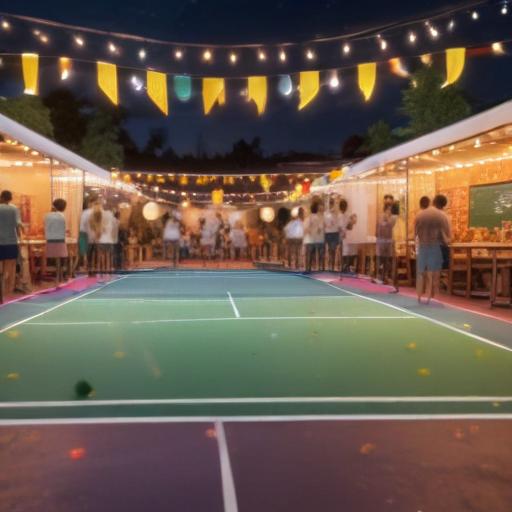The US Open is delivering a different kind of tennis experience this year, a jolt of energy that stands in stark contrast to Wimbledon’s famed hush. After the elegance and restraint of the green courts, Flushing Meadows crackles with amplified sound, bright lights, and a crowd that feels more like a soccer match than a traditional tennis venue.
Fans arrive ready to celebrate, and the atmosphere matches the city around it. Between points, music blasts from speakers, crowds cheer and chant, and there’s a palpable sense that the tournament is as much a festival as a sport. Sports journalist Molly McElwee, who has covered the US Open in recent years, describes it as “an assault on the senses in every way,” noting the knockout blend of spectacle, noise, and color that New York brings to the event. The Honey Deuce cocktails flowing through the stands aren’t just a novelty; they’re part of a broader sense that this is a show where spectators are completely immersed.
The energy isn’t limited to the big arena. Arthur Ashe Stadium, the biggest tennis venue in the world, channels this fevered pulse, while smaller courts glow with their own intensities. McElwee recalls Serena Williams’ 2022 run at the Open as a quintessential example of the crowd’s power—united, loud, and deeply engaged in every rally. For many players, this environment is a test of focus as much as a test of skill.
Yet the openness of the crowd can be a double-edged sword. Some players and officials have noted the challenges of staying anchored amid a flood of stimuli. One moment from the early rounds drew particular attention: during Daniil Medvedev’s clash with Benjamin Bonzi in Louis Armstrong Stadium, a cameraman wandered onto the court just as Bonzi was serving for the match. The ensuing delay, sparked by the disruption, saw Medvedev whip the crowd into a frenzy, and the match stretched on as fans roared. Bonzi, reflecting after the match, described it as “weird” and difficult to refocus, a reminder that in this setting, every mid-match moment can become a spectacle in itself.
There have also been smaller, more personal moments that underscored the atmosphere’s unpredictable flavor. A fan’s unexpected switch in allegiance during a set offered a glimpse into the event’s sometimes chaotic theater, a phenomenon that players like Jacob Fearnley described as loud and confusing, yet part of what makes the Open feel so alive.
Amid the din, there are players who embrace the chaos. Frances Tiafoe, known for his expressive approach to the game, has argued that a little drama can be a positive force, describing the medley of pantomime and competition as funny and exhilarating. Ben Shelton, who reached the Open’s semifinals in 2023, says he thrives on the energy of a packed, buzzing arena, insisting there’s no place like the US Open for a player who wants to feel the sport in its most electric form. Emma Navarro, another American voice, recognizes the appeal of the environment but offers a practical note: the sheer scale of Arthur Ashe means fans are as likely to stroll and chat as they are to watch every point—an experience she says can ease the pressure of being watched intensely.
The conditions around the tournament—fans, vendors, and a city that thrives on tempo—also bring practical distractions. Some players have commented on the odors wafting through the grounds, with marijuana among the scents noted by Casper Ruud. The issue has drawn into sharper focus given New York State’s recreational use laws, but it’s treated by many as just another facet of a tournament that lives at the intersection of sport and city life.
What does this mean for the sport and its followers? The US Open’s noisy, vibrant atmosphere is shaping discussions about the future of tennis events. For players, it’s a different kind of test: the ability to tune out or lean into the crowd, to manage energy over long matches on a hot, late-year calendar, and to perform under conditions that feel more like a festival than a conventional tennis match. For fans, it’s a more immersive, accessible experience, a place where you can grab a beer, enjoy the spectacle, and still witness high-level competition. For sponsors and organizers, the energy translates into engaging branding opportunities and a platform for stories that go beyond the skill on court.
In the broader arc of the sport, the Open’s atmosphere seems to reflect a shift in how tennis tournaments relate to their cities and audiences. McElwee notes that the variety of winners in the past decade may partly reflect this evolving dynamic—the combination of rigorous competition with a more inclusive, party-like environment that keeps energy high and fans engaged longer.
If there’s a takeaway, it’s that the US Open has found a distinctive identity that many players say they thrive in, even when the moment feels chaotic. The tournament’s blend of thunderous crowds, city grit, and high-stakes tennis continues to attract a new generation of fans while challenging veteran competitors to stay precise amid the noise.
What to watch going forward
– Player adaptability: More athletes may prioritize mental routines and crowd management to convert the energy into consistent on-court performance.
– Audience experience: Expect continued innovation in food, drink, music, and on-site entertainment to deepen the festival vibe without compromising the sport’s integrity.
– City-sport synergy: The Open’s relationship with New York’s pace and culture could inspire other venues to embrace regional flair while preserving tennis’ competitive edge.
Summary in short
The US Open is redefining tennis culture with a louder, more dynamic atmosphere that mirrors New York’s own energy. While the chaos can challenge players, it also creates a uniquely engaging spectator experience that many athletes and fans say enhances the drama and appeal of the game. Whether you love the energy or prefer the discipline of quieter venues, the Open’s electric environment is here to stay—and it’s shaping how the sport is played, watched, and celebrated.
